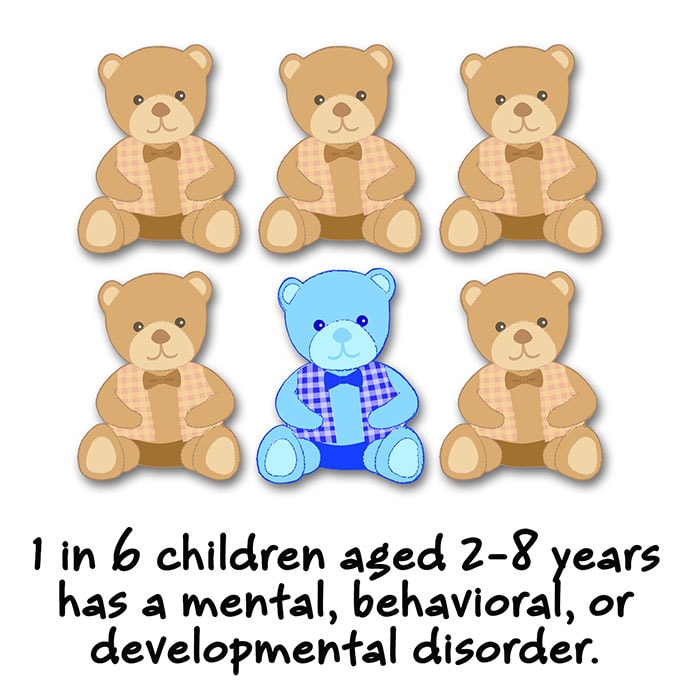Data and Statistics on Children’s Mental Health
Mental health is an important part of children’s overall health and well-being. Mental health includes children’s mental, emotional, and behavioral well-being. It affects how children think, feel, and act. It also plays a role in how children handle stress, relate to others, and make healthy choices.
Mental disorders among children are described as serious changes in the way children typically learn, behave, or handle their emotions, causing distress and problems getting through the day.1 Among the more common mental disorders that can be diagnosed in childhood are attention-deficit/hyperactivity disorder (ADHD), anxiety, and behavior disorders.
There are different ways to assess mental health and mental disorders in children. CDC uses surveys, like the National Survey of Children’s Health, to describe the presence of positive indicators of children’s mental health and to understand the number of children with diagnosed mental disorders and whether they received treatment. In this type of survey, parents report on indicators of positive mental health for their child and report any diagnoses their child has received from a healthcare provider. The information on this page provides data about indicators of positive mental health in children and mental health disorders that are most common in children.
Facts about mental health in U.S. children
National data on positive mental health indicators that describe mental, emotional, and behavioral well-being for children are limited. Based on the data we do have:
- Indicators of positive mental health are present in most children. Parents reported in 2016-2019 that their child mostly or always showed:
- Affection (97.0%), resilience (87.9%), positivity (98.7%) and curiosity (93.9%) among children ages 3-5 years2
- Curiosity (93.0%), persistence (84.2%), and self-control (73.8%) among children ages 6-11 years2
- Curiosity (86.5 %), persistence (84.7%), and self-control (79.8%) among children ages 12-17 years2
Facts about mental disorders in U.S. children
- ADHD, anxiety problems, behavior problems, and depression are the most commonly diagnosed mental disorders in children. Estimates for ever having a diagnosis among children aged 3-17 years, in 2016-19, are given below.
- Some of these conditions commonly occur together. For example, among children aged 3-17 years in 2016:
- Having another mental disorder was most common in children with depression: about 3 in 4 children with depression also had anxiety (73.8%) and almost 1 in 2 had behavior problems (47.2%).3
- For children with anxiety, more than 1 in 3 also had behavior problems (37.9%) and about 1 in 3 also had depression (32.3%).3
- For children with behavior problems, more than 1 in 3 also had anxiety (36.6%) and about 1 in 5 also had depression (20.3%).3
- Depression and anxiety have increased over time
- “Ever having been diagnosed with either anxiety or depression” among children aged 6–17 years increased from 5.4% in 2003 to 8% in 2007 and to 8.4% in 2011–2012.4
- “Ever having been diagnosed with anxiety” increased from 5.5% in 2007 to 6.4% in 2011–2012.4
- “Ever having been diagnosed with depression” did not change between 2007 (4.7%) and 2011-2012 (4.9%).4
- For adolescents, depression, substance use and suicide are important concerns. Among adolescents aged 12-17 years in 2018-2019 reporting on the past year:
-
- 15.1% had a major depressive episode.2
- 36.7% had persistent feelings of sadness or hopelessness.2
- 4.1% had a substance use disorder.2
- 1.6% had an alcohol use disorder.2
- 3.2% had an illicit drug use disorder.2
- 18.8% seriously considered attempting suicide.2
- 15.7% made a suicide plan.2
- 8.9% attempted suicide.2
- 2.5% made a suicide attempt requiring medical treatment.2
Learn more about high-risk substance use among youth. Learn more about suicide.
- Treatment rates vary among different mental disorders. Among children aged 3-17 years, in 2016:
- Mental, behavioral, and developmental disorders begin in early childhood
- 1 in 6 U.S. children aged 2–8 years (17.4%) had a diagnosed mental, behavioral, or developmental disorder.5
- Prevalence of mental disorders change with age
- Many family, community, and healthcare factors are related to children’s mental health
- Among children aged 2-8 years, boys were more likely than girls to have a mental, behavioral, or developmental disorder.5
- Among children living below 100% of the federal poverty level, more than 1 in 5 (22%) had a mental, behavioral, or developmental disorder.5
- Age and poverty level affected the likelihood of children receiving treatment for anxiety, depression, or behavior problems.3
- Adverse childhood events (ACEs) are associated with children’s physical and mental health. In 2016-2019, among children aged 6-17 years:
- Children who were discriminated against based on race or ethnicity had higher percentages of one or more physical health conditions (37.8% versus 27.1%), and one or more mental health conditions (28.9% versus 17.8%).6
- Racial/ethnic discrimination was almost seven times as common among children with three other ACEs compared to those with no other ACEs.6
Note: The estimates reported on this page are based on parent report, using nationally representative surveys. This method has several limitations. It is not known to what extent children receive these diagnoses accurately. Estimates based on parent-reported diagnoses may match those based on medical records,7 but some children may also have mental disorders that have not been diagnosed, or receive diagnoses that may not be the best fit for their symptoms. Limited information on measuring children’s mental health nationally is available2.
Read more about children’s mental health from a community study.
Access to mental health treatment
Early diagnosis and appropriate services for children and their families can make a difference in the lives of children with mental disorders.7 Access to providers who can offer services, including screening, referrals, and treatment, varies by location. CDC is working to learn more about access to behavioral health services and supports for children and their families.
What is It and Why is It Important?
Data sources for mental health and related conditions
There are many different datasets which include information on children’s mental health and related conditions for children living in the United States.
Healthy People 2030
Healthy People 2030 sets data-driven national objectives to improve health and well-being over the next decade, including children’s mental health and well-being.
National Survey of Family Growth (NSFG)
NSFG gathers information on family life, marriage and divorce, pregnancy, infertility, use of contraception, and general and reproductive health.
National Health and Nutrition Examination Survey (NHANES)
NHANES assesses health and nutritional status through interviews and physical examinations, and includes conditions, symptoms, and concerns associated with mental health and substance abuse, as well as the use and need for mental health services.
National Health Interview Survey (NHIS)
NHIS collects data on children’s mental health, mental disorders, such as ADHD, autism spectrum disorder, depression and anxiety problems, and use and need for mental health services.
National Survey of Children’s Health (NSCH)
NSCH examines the health of children, with emphasis on well-being, including medical homes, family interactions, the health of parents, school and after-school experiences, and safe neighborhoods. This survey was redesigned in 2016.
For previous versions of this survey, see also:
National Survey of Children’s Health (NSCH 2003, 2007, 2011-12)
National Survey of Children with Special Healthcare Needs (NS-CSHCN 2001, 2005-6, 2009-10)
National Survey of the Diagnosis and Treatment of ADHD and Tourette Syndrome (NS-DATA)
NS-DATA collects information about children, 2-15 years old in 2011-2012, who had ever been diagnosed with ADHD and/or Tourette syndrome (TS), with the goal of better understanding diagnostic practices, level of impairment, and treatments for this group of children.
National Survey on Drug Use and Health (NSDUH)
NSDUH, administered by the Substance Abuse and Mental Health Services Administration (SAMHSA), provides national- and state-level data on the use of tobacco, alcohol, and illicit drugs (including non-medical use of prescription drugs), as well as data on mental health in the United States.
National Vital Statistics System (NVSS)
NVSS contains vital statistics from the official records of live births, deaths, causes of death, marriages, divorces, and annulment recorded by states and independent registration areas
National Youth Tobacco Survey (NYTS)
NYTS is a nationally representative school-based survey on tobacco use by public school students enrolled in grades 6-12.
School Associated Violent Death Study (SAVD)
SAVD plays an important role in monitoring trends related to school-associated violent deaths (including suicide), identifying the factors that increase the risk, and assessing the effects of prevention efforts.
School Health Policies and Programs Study (SHPPS)
SHPPS is a national survey assessing school health policies and practices at the state, district, school, and classroom levels. Collected data includes mental health and social service policies.
Web-based Injury Statistics Query and Reporting System (WISQARS)
WISQARS is an interactive database system that provides customized reports of injury-related data.
Youth Risk Behavior Surveillance System (YRBSS)
The YRBSS monitors health-risk behaviors, including tobacco use, substance abuse, unintentional injuries and violence, sexual behaviors that contribute to unintended pregnancy, and sexually transmitted diseases.
References
- Perou R, Bitsko RH, Blumberg SJ, Pastor P, Ghandour RM, Gfroerer JC, Hedden SL, Crosby AE, Visser SN, Schieve LA, Parks SE, Hall JE, Brody D, Simile CM, Thompson WW, Baio J, Avenevoli S, Kogan MD, Huang LN. Mental health surveillance among children – United States, 2005—2011. MMWR 2013;62(Suppl; May 16, 2013):1-35. [Read summary]
- Bitsko RH, Claussen AH, Lichtstein J, Black LJ, Everett Jones S, Danielson MD, Hoenig JM, Davis Jack SP, Brody DJ, Gyawali S, Maenner MM, Warner M, Holland KM, Perou R, Crosby AE, Blumberg SJ, Avenevoli S, Kaminski JW, Ghandour RM. Surveillance of Children’s Mental Health – United States, 2013 – 2019 MMWR, , 2022 / 71(Suppl-2);1–42. [Read article]
- Ghandour RM, Sherman LJ, Vladutiu CJ, Ali MM, Lynch SE, Bitsko RH, Blumberg SJ. Prevalence and treatment of depression, anxiety, and conduct problems in U.S. children. The Journal of Pediatrics, 2018. Published online before print October 12, 2018 [Read summary]
- Bitsko RH, Holbrook JR, Ghandour RM, Blumberg SJ, Visser SN, Perou R, Walkup J. Epidemiology and impact of healthcare provider diagnosed anxiety and depression among US children. Journal of Developmental and Behavioral Pediatrics. Published online before print April 24, 2018 [Read summary]
- Cree RA, Bitsko RH, Robinson LR, Holbrook JR, Danielson ML, Smith DS, Kaminski JW, Kenney MK, Peacock G. Health care, family, and community factors associated with mental, behavioral, and developmental disorders and poverty among children aged 2–8 years — United States, 2016. MMWR, 2018;67(5):1377-1383. [Read article]
- Hutchins HJ, Barry CM, Valentine V, Bacon S, Njai R, Claussen AH, Ghandour RM, Lebrun-Harris LA, Perkins K, Robinson LR (submitted). Perceived racial/ethnic discrimination, physical and mental health conditions in childhood, and the relative role of other adverse experiences. Adversity and Resilience Science published online May 23, 2022. [Read summary]
- US Department of Health and Human Services Health Resources and Services Administration & Maternal and Child Health Bureau. Mental health: A report of the Surgeon General. Rockville, MD: US Department of Health and Human Services, Substance Abuse and Mental Health Services Administration, Center for Mental Health Services, and National Institutes of Health, National Institute of Mental Health; 1999. [Read report]


